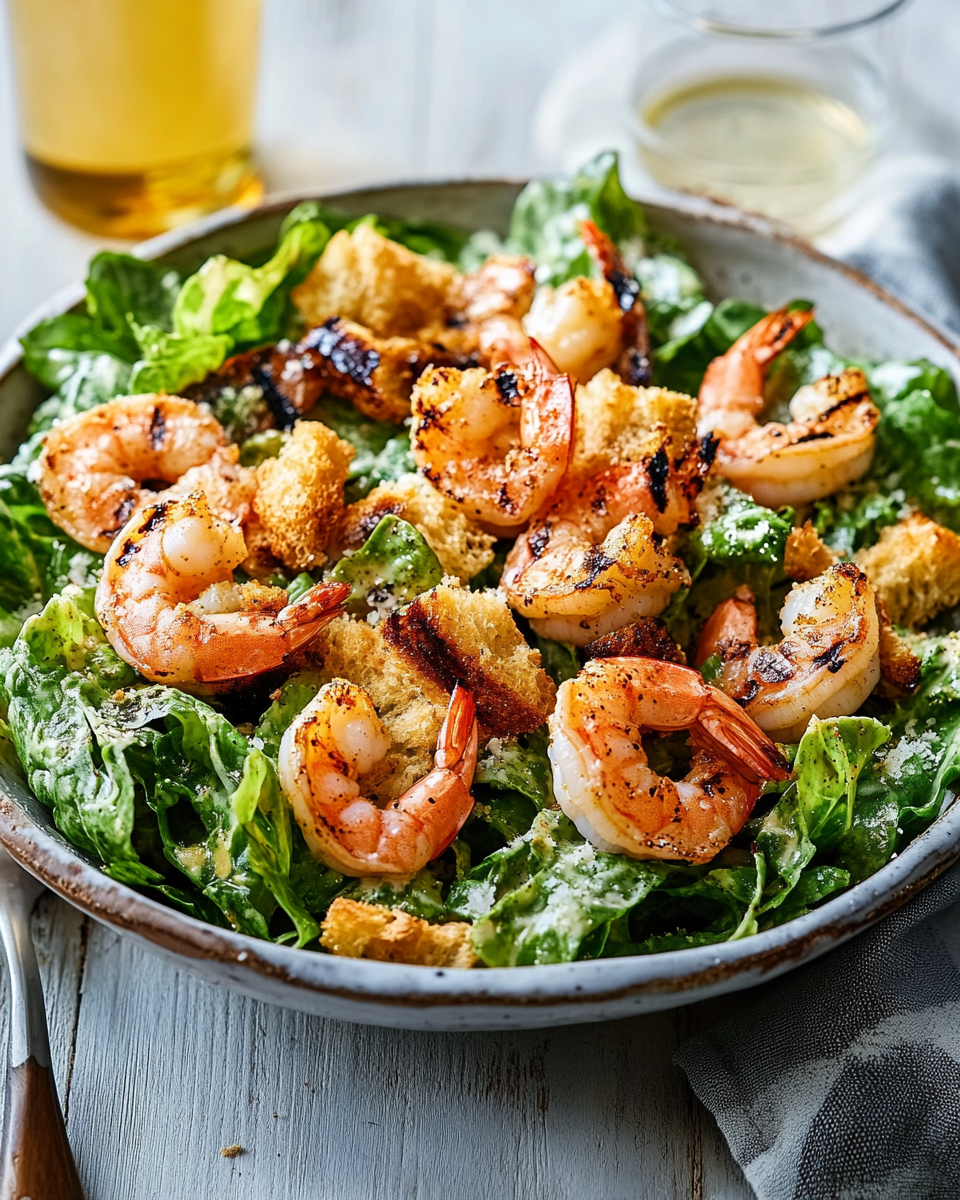Shrimp Caesar Salad with Garlic Croutons is a fresh and flavorful twist on the classic Caesar salad. By adding succulent, perfectly cooked shrimp, this dish transforms into a satisfying meal that’s both light and protein-packed. The crisp romaine lettuce, creamy Caesar dressing, and savory Parmesan cheese combine beautifully with the crunchy, garlicky croutons to create a harmonious blend of textures and tastes. Perfect for lunch, dinner, or entertaining guests, this salad offers a delicious balance of indulgence and nutrition that appeals to seafood lovers and salad enthusiasts alike.
FULL RECIPE
Ingredients
- 1 lb large shrimp, peeled and deveined
- 1 tbsp olive oil
- Salt and pepper, to taste
- 1 head romaine lettuce, chopped
- ½ cup Caesar dressing
- ¼ cup grated Parmesan cheese
- 2 cups cubed French bread
- 2 tbsp butter
- 2 cloves garlic, minced
Directions
- Preheat oven to 375°F (190°C).
- In a skillet, melt butter over medium heat. Add garlic and cook for 1 minute.
- Toss bread cubes in garlic butter until coated. Spread on a baking sheet and bake for 10–12 minutes or until golden and crisp, turning halfway. Set aside to cool.
- Toss shrimp with olive oil, salt, and pepper. Grill or sauté over medium-high heat for 2–3 minutes per side, until opaque and cooked through.
- In a large bowl, combine chopped romaine, Caesar dressing, and Parmesan. Toss well.
- Top salad with cooked shrimp and garlic croutons. Serve immediately.
Nutritional Information
- Calories: 460
- Protein: 28g
- Carbohydrates: 22g
- Dietary Fiber: 3g
- Sugars: 2g
- Total Fat: 29g
- Saturated Fat: 7g
- Cholesterol: 220mg
- Sodium: 980mg
The Origins of Caesar Salad
The Caesar salad is believed to have originated in Tijuana, Mexico, during the 1920s, created by restaurateur Caesar Cardini. While the original version was quite simple, consisting mainly of romaine lettuce, croutons, Parmesan cheese, and a tangy dressing, the salad has evolved significantly over the years. Adding shrimp to the classic Caesar salad introduces a fresh seafood twist that enhances its flavor profile and transforms it from a side dish or appetizer into a satisfying main course. This fusion of classic and seafood elements makes Shrimp Caesar Salad a popular choice in contemporary menus worldwide.
Why Shrimp Works Perfectly in Caesar Salad
Shrimp is a lean, protein-rich seafood that pairs exceptionally well with the creamy, garlicky Caesar dressing. Its mild flavor complements the sharpness of Parmesan cheese and the crunch of romaine lettuce, while the garlic croutons add an extra layer of texture and taste. Additionally, shrimp cooks quickly, making it an easy ingredient to prepare, which balances the effort required for assembling the salad. This combination creates a balanced meal that is both flavorful and nutritious.
Health Benefits of Shrimp Caesar Salad
This salad offers a nutritious balance of macronutrients. Shrimp is low in calories but high in protein, making it ideal for muscle maintenance and repair. The romaine lettuce is rich in vitamins A and K, essential for vision and bone health. Garlic croutons add carbohydrates for energy, while the olive oil and butter provide healthy fats that support brain function. However, the Caesar dressing can be high in fat and sodium, so opting for a lighter dressing or homemade version can improve the salad’s overall health profile.
The Role of Garlic Croutons
Garlic croutons are not just a crunchy addition but a vital flavor enhancer in the Shrimp Caesar Salad. The garlic infuses the bread cubes with a savory punch that elevates the salad beyond basic greens. When baked with butter, the croutons become crispy and aromatic, providing a satisfying contrast to the tender shrimp and fresh lettuce. Homemade croutons also allow control over ingredients, reducing preservatives and unhealthy fats found in store-bought varieties.
Variations of Caesar Salad with Seafood
While shrimp is a popular addition, Caesar salad variations with seafood are widespread. Some use grilled salmon, seared scallops, or even anchovies to add umami and depth. These variations offer different textures and flavors while maintaining the classic essence of the Caesar. Experimenting with different seafood types allows for customization based on dietary preferences or seasonal availability, making the salad versatile for different occasions.
Pairing Shrimp Caesar Salad with Wine
Pairing a beverage with Shrimp Caesar Salad can elevate the dining experience. Light, crisp white wines like Sauvignon Blanc or Pinot Grigio work well due to their acidity, which cuts through the richness of the dressing and complements the shrimp’s delicate flavor. For those who prefer non-alcoholic options, sparkling water with lemon or iced green tea also balances the salad’s creamy and garlicky notes.
Tips for Preparing the Perfect Shrimp
To achieve the best texture and flavor, it’s important to properly prepare the shrimp. Fresh or properly thawed shrimp should be deveined and peeled before cooking. Cooking shrimp quickly over medium-high heat prevents it from becoming rubbery. Marinating shrimp briefly in lemon juice, garlic, or herbs can add extra flavor without overpowering the salad. Grilling or pan-searing is preferred to retain juiciness and impart a subtle smoky note.
Caesar Dressing: The Heart of the Salad
The Caesar dressing is a creamy emulsion traditionally made with anchovies, garlic, egg yolk, lemon juice, Dijon mustard, olive oil, and Parmesan cheese. It’s the dressing’s unique combination of savory, tangy, and slightly salty flavors that defines the salad. While many store-bought dressings are available, making it fresh at home ensures better control of ingredients and a more authentic taste, which enhances the overall quality of the Shrimp Caesar Salad.
The Importance of Fresh Romaine Lettuce
Romaine lettuce is the foundation of the Caesar salad. Its crisp texture and slightly bitter flavor provide the perfect contrast to the creamy dressing and savory shrimp. Choosing fresh, vibrant romaine is essential for the salad’s success; wilted or old lettuce will negatively affect the texture and flavor. Washing and thoroughly drying the lettuce before assembling the salad help keep it crisp and refreshing.
Nutritional Considerations and Modifications
While the Shrimp Caesar Salad is nutritious, some may want to adjust it to fit specific dietary needs. For example, those watching sodium intake should use low-sodium shrimp and a lighter Caesar dressing. To reduce fat, swapping butter for olive oil in croutons or using yogurt-based dressing alternatives can help. Adding extra vegetables like cherry tomatoes or cucumbers can boost fiber and vitamins without altering the beloved taste drastically.
Serving Suggestions and Meal Pairings
Shrimp Caesar Salad can be served as a light lunch or dinner. It pairs well with crusty bread, a bowl of soup, or grilled vegetables to make a complete meal. For gatherings or parties, it can be plated as individual servings or presented family-style in a large bowl. Garnishing with extra Parmesan, freshly ground black pepper, or lemon wedges adds visual appeal and enhances the eating experience.
Storing and Leftover Tips
If you have leftovers, it’s best to store components separately. Keep the dressing, shrimp, and croutons in airtight containers and the lettuce refrigerated. This prevents sogginess and preserves freshness. When ready to eat, toss everything together just before serving. Shrimp can be reheated gently, but croutons are best enjoyed fresh to maintain their crunch.
Conclusion
Shrimp Caesar Salad with Garlic Croutons is a delightful and versatile dish that combines the classic Caesar salad’s timeless flavors with the fresh, tender taste of shrimp. It offers a well-rounded meal that is both satisfying and nutritious, perfect for those seeking a flavorful yet light option. Its adaptability to various dietary preferences and occasions makes it a favorite among seafood lovers and salad enthusiasts alike. Whether for a quick lunch or an elegant dinner, this salad delivers bold taste and texture that never disappoint.






